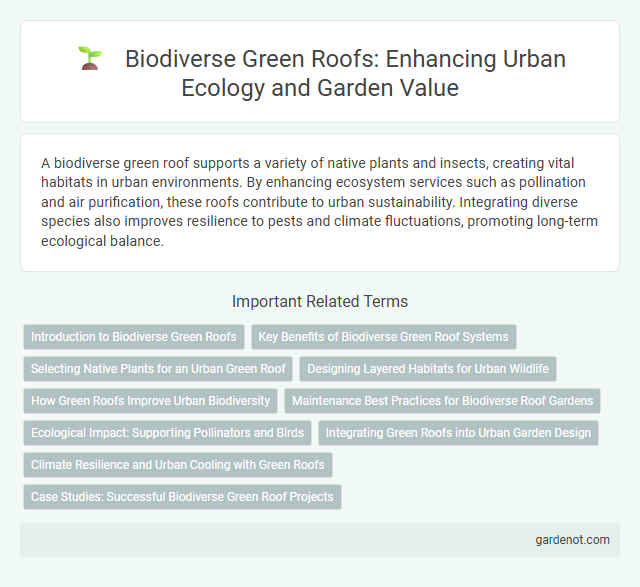A biodiverse green roof supports a variety of native plants and insects, creating vital habitats in urban environments. By enhancing ecosystem services such as pollination and air purification, these roofs contribute to urban sustainability. Integrating diverse species also improves resilience to pests and climate fluctuations, promoting long-term ecological balance.
Introduction to Biodiverse Green Roofs
Biodiverse green roofs incorporate a variety of native plant species and habitats to support local wildlife and enhance urban ecosystems. These roofs improve air quality, reduce stormwater runoff, and provide habitat for pollinators and birds, contributing to urban biodiversity. Effective design prioritizes native flora diversity, substrate composition, and structural layering to create sustainable, resilient green roof environments.
Key Benefits of Biodiverse Green Roof Systems
Biodiverse green roof systems significantly enhance urban biodiversity by providing habitats for pollinators, birds, and beneficial insects, which helps support local ecosystems and promotes ecological balance. These roofs improve stormwater management by absorbing and filtering rainwater, reducing runoff volume and decreasing the risk of urban flooding. Furthermore, biodiverse green roofs contribute to better air quality and thermal regulation, lowering urban heat island effects and reducing energy consumption in buildings.
Selecting Native Plants for an Urban Green Roof
Selecting native plants for a biodiverse green roof enhances local ecosystem resilience by supporting indigenous pollinators and wildlife. Native species are better adapted to urban microclimates, requiring less maintenance, water, and fertilizers, which promotes sustainability. Integrating a variety of native flora maximizes habitat diversity, improves air quality, and moderates urban heat island effects effectively.
Designing Layered Habitats for Urban Wildlife
Biodiverse green roofs enhance urban ecosystems by creating layered habitats that support a variety of wildlife, including pollinators, birds, and beneficial insects. Incorporating diverse plant species, varying substrate depths, and structural elements like logs or stones fosters microhabitats essential for nesting, foraging, and shelter. These multi-layered designs increase ecological connectivity and promote resilience in city environments.
How Green Roofs Improve Urban Biodiversity
Biodiverse green roofs enhance urban biodiversity by providing habitats for various plant species, insects, and birds, effectively creating mini-ecosystems in city environments. These living roofs support pollinators like bees and butterflies, contributing to healthy urban ecosystems while reducing the heat island effect. Incorporating native flora in green roof design maximizes ecological benefits and fosters resilience against urban environmental stresses.
Maintenance Best Practices for Biodiverse Roof Gardens
Biodiverse green roofs require specialized maintenance best practices to sustain a thriving ecosystem and promote habitat diversity. Regular inspections for plant health, invasive species control, and adaptive watering schedules are essential to support native flora and fauna. Integrating organic mulching, seasonal pruning, and minimal chemical use enhances soil quality and fosters a balanced microhabitat on biodiverse roof gardens.
Ecological Impact: Supporting Pollinators and Birds
Biodiverse green roofs create vital habitats that support pollinators such as bees, butterflies, and native birds by providing diverse flowering plants and nesting opportunities. These ecosystems enhance urban biodiversity, improving ecosystem services like pollination and pest control. Supporting pollinator populations on green roofs contributes to increased plant resilience and urban agricultural productivity.
Integrating Green Roofs into Urban Garden Design
Biodiverse green roofs enhance urban garden design by incorporating native plant species that support local wildlife, improving ecosystem resilience and air quality. Integrating diverse vegetation layers on green roofs increases habitat complexity, promoting pollinators and beneficial insects within dense city environments. These sustainable installations contribute to urban biodiversity, stormwater management, and temperature regulation, making cities more livable and environmentally balanced.
Climate Resilience and Urban Cooling with Green Roofs
Biodiverse green roofs enhance climate resilience by supporting a variety of plant species that improve stormwater management and reduce urban heat islands. These green roofs lower ambient temperatures through evapotranspiration and provide critical habitats for pollinators and birds, increasing urban biodiversity. Integrating diverse vegetation on rooftops contributes to sustainable urban cooling while mitigating the impacts of extreme weather events.
Case Studies: Successful Biodiverse Green Roof Projects
Numerous case studies highlight the success of biodiverse green roof projects, such as the Nanyang Technological University in Singapore, which supports over 100 native plant species, boosting urban biodiversity. The Chicago City Hall green roof demonstrates improved stormwater management and habitat creation, attracting pollinators and birds. These projects show that incorporating diverse native flora enhances ecosystem services, reduces heat island effects, and fosters urban wildlife habitats effectively.
Biodiverse green roof Infographic

 gardenot.com
gardenot.com